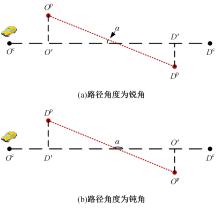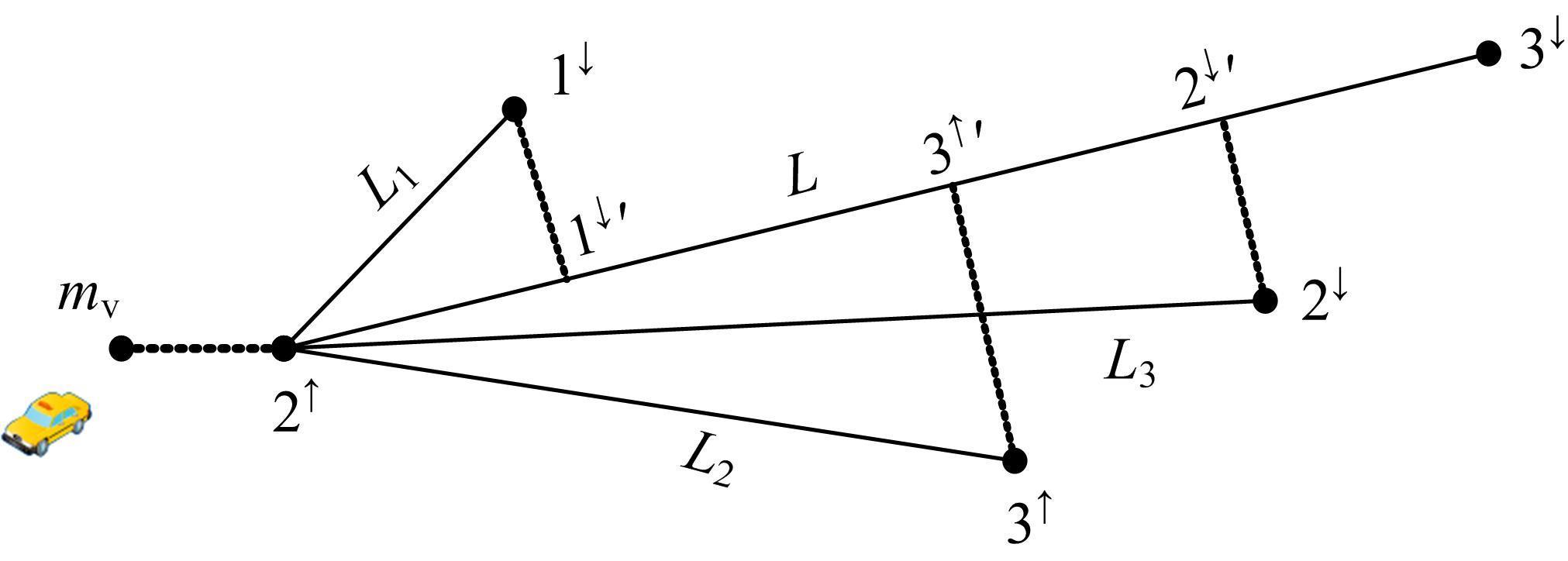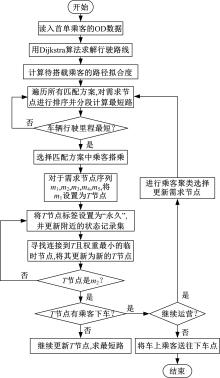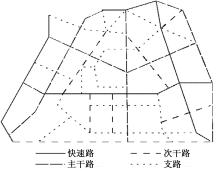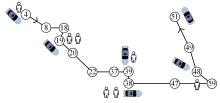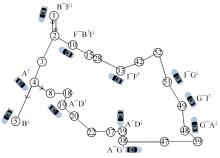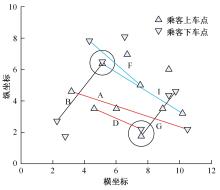吉林大学学报(工学版) ›› 2022, Vol. 52 ›› Issue (3): 564-571.doi: 10.13229/j.cnki.jdxbgxb20200843
• 交通运输工程·土木工程 • 上一篇
终点不确定条件下网约车合乘匹配模型及算法
- 吉林大学 交通学院,长春 130022
Ride⁃sharing matching model and algorithm of online car⁃hailing under condition of uncertain destination
Hong-fei JIA( ),Zi-han SHAO,Li-li YANG(
),Zi-han SHAO,Li-li YANG( )
)
- College of Transportation,Jilin University,Changchun 130022,China
摘要:
为了改善出租车行业高需求和低载客率的现象,本文对运营网约车合乘问题进行了研究。综合考虑车辆运输里程、乘客周转量、出行时间以及出行费用建立了单车辆合乘匹配数学模型。基于公平原则,考虑了司机和乘客双边利益,提出了一种费率计算方法。基于路径拟合度进行乘客聚类,以Dijkstra算法为基础提出了带有必经节点的分路段最短路径算法。算例结果表明:相比传统出租车运营模式,网约车合乘对于提高运输效率、降低运输成本具有显著效果。
中图分类号:
- U492.2
| 1 | Herbawi W, Weber M. The ride matching problem with time windows in dynamic ridesharing: A model and a genetic algorithm[C]∥Evolutionary Computation, Brisbane, QLD, Australia, 2012: 1-8. |
| 2 | Naor M. On fairness in the carpool problem[J]. Journal of Algorithms, 2005, 55(1): 93-98. |
| 3 | Lee K T, Wu P J, Wang S H. The planning and design of taxi pooling on feeder system[C]∥2004 IEEE International Conference on Networking, Sensing and Control, Taipei, Taiwan, China, 2004: 376-381. |
| 4 | Ma S, Zheng Y, Wolfson O. T-share: a large-scale dynamic taxi ridesharing service[C]∥2013 IEEE 29th International Conference on Data Engineering, Brisbane, QLD, Australia, 2013: 410-421. |
| 5 | Lauri H. An adaptive insertion algorithm for the single-vehicle dial-a-ride problem with narrow time windows[J]. European Journal of Operational Research, 2011, 209(1): 11-22. |
| 6 | Alonso-Mora J, Samaranayake S, Wallar A, et al. On-demand high-capacity ride-sharing via dynamic trip-vehicle assignment[J]. Proceedings of the National Academy of Sciences of the United States of America, 2017, 114(3): 462-467. |
| 7 | 沈弼龙, 赵颖, 黄艳, 等. 大数据背景下动态共乘的研究进展[J]. 计算机研究与发展, 2017, 54(1): 34-43. |
| Shen Bi-long, Zhao Ying, Huang Yan, et al. Survey on dynamic ride sharing in big data era[J]. Journal of Computer Research and Development, 2017, 54(1): 34-43. | |
| 8 | 覃运梅, 石琴. 出租车合乘模式的探讨[J]. 合肥工业大学学报: 自然科学版, 2006, 29(1): 77-79, 101. |
| Qin Yun-mei, Shi Qin. Research on the combined-taxi mode[J]. Journal of Hefei University of technology (Natural Science), 2006, 29(1): 77-79, 101. | |
| 9 | 吴玥琳, 袁振洲, 陈秋芳, 等. 考虑轨迹相似度的综合客运枢纽出租车合乘方法研究[J]. 交通运输系统工程与信息, 2020, 20(2): 188-195. |
| Wu Yue-lin, Yuan Zhen-zhou, Chen Qiu-fang, et al. Taxi pooling method of urban integrated passenger transport hub with trajectory similarity[J]. Journal of Transportation Systems Engineering and Information Technology, 2020, 20(2): 188-195. | |
| 10 | 宋超超, 王洪国, 邵增珍, 等. 一种求解多车辆合乘匹配问题的适应性算法[J]. 计算机科学, 2013, 40(2): 222-228. |
| Song Chao-chao, Wang Hong-guo, Shao Zeng-zhen, et al. Adaptive algorithm for MRMP[J]. Computer Science, 2013, 40(2): 222-228. | |
| 11 | 唐方慧. 出租车合乘路径选择及费率优化问题研究[D]. 兰州:兰州交通大学交通运输学院, 2016. |
| Tang Fang-hui. The research on the optimization of taxi ride-sharing route and rate[D]. Lanzhou: School of Traffic and Transportation, Lanzhou Jiaotong University, 2016. | |
| 12 | 卢雨婷, 李登峰, 胡勋锋. 基于破产模型的出租车合乘定价方法[J]. 交通运输系统工程与信息, 2017, 17(4): 7-12. |
| Lu Yu-ting, Li Deng-feng, Hu Xun-feng. A pricing method for ride-sharing taxi based on the bankruptcy model[J]. Journal of Transportation Systems Engineering and Information Technology, 2017, 17(4): 7-12. | |
| 13 | 鹿应荣, 杨印生, 吕锋. 基于模糊聚类分析的车辆优化调度[J]. 吉林大学学报: 工学版, 2006, 36(): 147-151. |
| Lu Ying-rong, Yang Yin-sheng, Lyu Feng. Optimal vehicle routing problem based on fuzzy clustering analysis[J] Journal of Jilin University (Engineering and Technology Edition), 2006, 36(Sup.2): 147-151. | |
| 14 | 赵宏伟, 刘宇琦, 董立岩, 等.智能交通混合动态路径优化算法[J].吉林大学学报:工学版, 2018, 48(4): 1214-1223. |
| Zhao Hong-wei, Liu Yu-qi, Dong Li-yan, Wang Yu, Liu Pei. Dynamic route optimization algorithm based on hybrid in ITS[J]. Journal of Jilin University (Engineering and Technology Edition), 2018, 48(4): 1214-1223. | |
| 15 | 高德地图. 2019年Q3中国主要城市交通分析报告[Z]. |
| [1] | 冯天军,孙学路,黄家盛,田秀娟,宋现敏. 基于三种过街方式的两相位信号交叉口延误[J]. 吉林大学学报(工学版), 2022, 52(3): 550-556. |
| [2] | 李先通,全威,王华,孙鹏程,安鹏进,满永兴. 基于时空特征深度学习模型的路径行程时间预测[J]. 吉林大学学报(工学版), 2022, 52(3): 557-563. |
| [3] | 薛锋,何传磊,黄倩,罗建. 多式轨道交通网络的耦合协调度[J]. 吉林大学学报(工学版), 2021, 51(6): 2040-2050. |
| [4] | 杨世军,裴玉龙,潘恒彦,程国柱,张文会. 城市公交车辆驻站时间特征分析及预测[J]. 吉林大学学报(工学版), 2021, 51(6): 2031-2039. |
| [5] | 贾彦峰,曲大义,林璐,姚荣涵,马晓龙. 基于运行轨迹的网联混合车流速度协调控制[J]. 吉林大学学报(工学版), 2021, 51(6): 2051-2060. |
| [6] | 陆文琦,周天,谷远利,芮一康,冉斌. 基于张量分解理论的车道级交通流数据修复算法[J]. 吉林大学学报(工学版), 2021, 51(5): 1708-1715. |
| [7] | 卢凯,吴蔚,林观荣,田鑫,徐建闽. 基于KNN回归的客运枢纽聚集人数组合预测方法[J]. 吉林大学学报(工学版), 2021, 51(4): 1241-1250. |
| [8] | 彭博,张媛媛,王玉婷,唐聚,谢济铭. 基于自动编码机-分类器的视频交通状态自动识别[J]. 吉林大学学报(工学版), 2021, 51(3): 886-892. |
| [9] | 张健,吴坤润,杨敏,冉斌. 智能网联环境下交叉口双环自适应控制模型[J]. 吉林大学学报(工学版), 2021, 51(2): 541-548. |
| [10] | 王殿海,沈辛夷,罗小芹,金盛. 车均延误最小情况下的相位差优化方法[J]. 吉林大学学报(工学版), 2021, 51(2): 511-523. |
| [11] | 宋现敏,张明业,李振建,王鑫,张亚南. 动态公交专用道的设置及其仿真分析评价[J]. 吉林大学学报(工学版), 2020, 50(5): 1677-1686. |
| [12] | 孙宝凤,姜源,郑黎黎,崔万坤,任欣欣. 变覆盖半径下城市轨道交通维护保障网络设计模型[J]. 吉林大学学报(工学版), 2020, 50(2): 526-534. |
| [13] | 贾洪飞,丁心茹,杨丽丽. 城市潮汐车道优化设计的双层规划模型[J]. 吉林大学学报(工学版), 2020, 50(2): 535-542. |
| [14] | 尹超英,邵春福,王晓全,熊志华. 考虑空间异质性的建成环境对通勤方式选择的影响[J]. 吉林大学学报(工学版), 2020, 50(2): 543-548. |
| [15] | 张大伟,祝海涛. 考虑行人差异性的人群疏散最优决策理论模型[J]. 吉林大学学报(工学版), 2020, 50(2): 549-556. |
|
||
